 W
WAllium chinense is an edible species of Allium, native to China, and cultivated in many other countries. Its close relatives include the onion, shallot, leek, chive, and garlic.
 W
WAllium tuberosum is a species of plant native to the Chinese province of Shanxi, and cultivated and naturalized elsewhere in Asia and around the world.
 W
WAmaranthus is a cosmopolitan genus of annual or short-lived perennial plants collectively known as amaranths. Some amaranth species are cultivated as leaf vegetables, pseudocereals, and ornamental plants. Most of the Amaranthus species are summer annual weeds and are commonly referred to as pigweeds. Catkin-like cymes of densely packed flowers grow in summer or autumn. Amaranth varies in flower, leaf, and stem color with a range of striking pigments from the spectrum of maroon to crimson and can grow longitudinally from 1 to 2.5 metres tall with a cylindrical, succulent, fibrous stem that is hollow with grooves and bracteoles when mature. There are approximately 75 species in the genus, 10 of which are dioecious and native to North America with the remaining 65 monoecious species endemic to every continent from tropical lowlands to the Himalayas. Members of this genus share many characteristics and uses with members of the closely related genus Celosia. Amaranth grain is collected from the genus. The leaves of some species are also eaten.
 W
WAmaranthus dubius, the red spinach, Chinese spinach,, spleen amaranth, hon-toi-moi, yin choy, hsien tsai, or Arai keerai is a plant species. It belongs to the economically important family Amaranthaceae.
 W
WThe asparagus bean is a legume cultivated for its edible green pods containing immature seeds, like the green bean. It is also known as: yardlong bean, pea bean, long-podded cowpea, Chinese long bean, snake bean, and bodi/bora. Despite the common name of "yardlong", the pods are actually only about half a yard long, so the subspecies name sesquipedalis is a more accurate approximation.
 W
WBamboo shoots or bamboo sprouts are the edible shoots of many bamboo species including Bambusa vulgaris and Phyllostachys edulis. They are used as vegetables in numerous Asian dishes and broths. They are sold in various processed shapes, and are available in fresh, dried, and canned versions.
 W
WBok choy, pak choi, pichay/petsay, or pok choi is a type of Chinese cabbage. Chinensis varieties do not form heads and have green leaf blades with lighter bulbous bottoms instead, forming a cluster reminiscent of mustard greens. Chinensis varieties are popular in southern China, East Asia, and Southeast Asia. Being winter-hardy, they are increasingly grown in Northern Europe. Now considered a subspecies of Brassica rapa, this group was originally classified as its own species under the name Brassica chinensis by Carl Linnaeus. They are a member of the family of Brassicaceae or Cruciferae, also commonly known as the mustards, the crucifers, or the cabbage family.
 W
WBomdong (봄동) is a hardy early spring cabbage with tough, sweet leaves. The leaves of bomdong, unlike those of regular napa cabbages, fall to the sides, giving the plant a flat shape.
 W
WBrassica juncea, commonly brown mustard, Chinese mustard, Indian mustard, leaf mustard, Oriental mustard and vegetable mustard, is a species of mustard plant.
 W
WGai lan, kai-lan, Chinese broccoli, Chinese kale, or jie lan is a leaf vegetable with thick, flat, glossy blue-green leaves with thick stems, and florets similar to broccoli. Another Brassica oleracea cultivar, gai lan is in the group alboglabra. When gone to flower, its white blossoms resemble that of its cousin Matthiola incana or Hoary Stock. The flavor is very similar to that of broccoli, but slightly more bitter. It is also noticeably stronger than broccoli.
 W
WCapsella bursa-pastoris, known as shepherd's purse because of its triangular flat fruits, which are purse-like, is a small annual and ruderal flowering plant in the mustard family (Brassicaceae). It is native to eastern Europe and Asia minor, but is naturalized and considered a common weed in many parts of the world, especially in colder climates, including British Isles, where it is regarded as an archaeophyte, North America and China, but also in the Mediterranean and North Africa. C. bursa-pastoris is the second-most prolific wild plant in the world, and is common on cultivated ground and waysides and meadows.
 W
WChoy sum is a leafy vegetable commonly used in Chinese cuisine. It is a member of the genus Brassica of the mustard family, Brassicaceae. Choy sum is a transliteration of the Cantonese name, which can be literally translated as "heart of the vegetable". It is also known as Chinese flowering cabbage.
 W
WCleome gynandra is a species of Cleome that is used as a green vegetable. It is known by many common names including Shona cabbage, African cabbage, spiderwisp, cat's whiskers, chinsaga and stinkweed. It is an annual wildflower native to Africa but has become widespread in many tropical and sub-tropical parts of the world. It is an erect, branching plant generally between 25 cm and 60 cm tall. Its sparse leaves are each made up of 3–5 oval-shaped leaflets. The flowers are white, sometimes changing to rose pink as they age. The seed is a brown 1.5 mm diameter sphere. The leaves and flowers are both edible. The leaves have a strong bitter, sometimes peppery flavor similar to mustard greens.
 W
WCorchorus is a genus of about 40–100 species of flowering plants in the family Malvaceae, native to tropical and subtropical regions throughout the world.
 W
WDaikon or mooli, Raphanus sativus var. longipinnatus, is a mild-flavored winter radish usually characterized by fast-growing leaves and a long, white, napiform root. Originally native to continental East Asia, daikon is harvested and consumed throughout the region, as well as in South Asia, and is now available internationally. In some locations daikon is planted for its ability to break up compacted soils and recover nutrients, but not harvested.
 W
WGlebionis coronaria, formerly called Chrysanthemum coronarium, is a species of flowering plant in the daisy family. It is native to the Mediterranean region. It is cultivated and naturalized in East Asia and in scattered locations in North America.
 W
WIpomoea aquatica is a semi-aquatic, tropical plant grown as a vegetable for its tender shoots. This plant is known in English as water spinach, river spinach, water morning glory, water convolvulus, or by the more ambiguous names Chinese spinach, Chinese watercress, Chinese convolvulus or swamp cabbage, or kangkong in Southeast Asia and ong choy in Cantonese. Its place of origin is not known.
 W
WKalimeris indica, also known as Indian aster or Indian Kalimeris, is a flowering herbaceous perennial plant of the family Asteraceae (Compositae). Kalimeris indica, like other species in the genus of Kalimeris, occurs mainly in eastern Asian countries of China, Korea and Japan, and has been introduced to California and Hawaii.
 W
WLeaf celery, also called Chinese celery or Nan Ling celery, is a variety of celery cultivated in East Asian countries for its edible, flavorful stalks and leaves.
 W
WLeucaena leucocephala is a small fast-growing mimosoid tree native to southern Mexico and northern Central America and is now naturalized throughout the tropics.
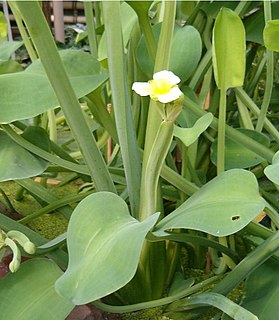 W
WLimnocharis flava is a species of aquatic flowering plant which is native to Mexico, Central America, South America, Cuba, Haiti and the Dominican Republic but widely naturalized in southern and southeastern Asia: India, Sri Lanka, Cambodia, Burma, Thailand, Vietnam, Indonesia, Malaysia, Brunei and southern China.
 W
WLimnophila aromatica, the rice paddy herb, is a tropical flowering plant in the family Plantaginaceae. It is native to Southeast Asia, where it flourishes in hot temperatures and grows most often in watery environments, particularly in flooded rice fields. It is called ngò ôm or ngò om or ngổ in Vietnam and used as an herb and also cultivated for use as an aquarium plant. The plant was introduced to North America in the 1970s due to Vietnamese immigration following the Vietnam War. It is called "ma om" (ម្អម) in Khmer. It is used in traditional Cambodian soup dishes and Southern Vietnamese cuisine. It can grow in flooded rice paddies during wet season but it grows best on drained but still wet sandy soil of harvested rice paddies for a few months after the rainy season ended. It dies out soon after it flowers. Rural Cambodians often harvest them and put them on the roof of their houses to dry for later use.
 W
WLuffa acutangula is a cucurbitaceous vine that is commercially grown for its unripe fruits as a vegetable. Mature fruits are used as natural cleaning sponges. Its fruit slightly resembles a cucumber or zucchini with ridges. It ranges from central and eastern Asia to southeastern Asia. It is also grown as a houseplant in places with colder climates. English common names include angled luffa, Chinese okra, dish cloth gourd, ridged gourd, sponge gourd, vegetable gourd, strainer vine, ribbed loofah, silky gourd, silk gourd, and sinkwa towelsponge.
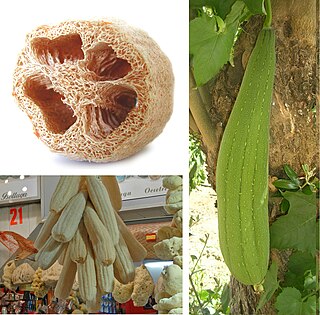 W
WLuffa cylindrica, the sponge gourd, Egyptian cucumber or Vietnamese luffa, is an annual species of vine cultivated for its fruit, native to South and Southeast Asia.
 W
WMarsilea crenata is a species of fern found in Southeast Asia. It is an aquatic plant looking like a four leaf clover. Leaves floating in deep water or erect in shallow water or on land. Leaflets glaucous, sporocarp ellipsoid, on stalks attached to base of petioles.
 W
WMelientha is a genus of plants in the family Opiliaceae described as a genus in 1888.
 W
WMomordica charantia is a tropical and subtropical vine of the family Cucurbitaceae, widely grown in Asia, Africa, and the Caribbean for its edible fruit. Its many varieties differ substantially in the shape and bitterness of the fruit.
 W
WMorinda citrifolia is a fruit-bearing tree in the coffee family, Rubiaceae. Its native range extends across Southeast Asia and Australasia, and was spread across the Pacific by Polynesian sailors. The species is now cultivated throughout the tropics and widely naturalized. Among some 100 names for the fruit across different regions are the more common English names of great morinda, Indian mulberry, noni, beach mulberry, and cheese fruit.
 W
WMoringa oleifera is a fast-growing, drought-resistant tree of the family Moringaceae, native to the Indian subcontinent. Common names include moringa, drumstick tree, horseradish tree, and ben oil tree or benzolive tree.
 W
WMung bean sprouts are a culinary vegetable grown by sprouting mung beans. They can be grown by placing and watering the sprouted beans in the shade until the hypocotyls grow long. Mung bean sprouts are extensively cultivated and consumed in East and Southeast Asia.
 W
WNapa or napa cabbage is a type of Chinese cabbage originating near the Beijing region of China and is widely used in East Asian cuisine. Since the 20th century, it has also become a widespread crop in Europe, the Americas and Australia. In much of the world, this is the vegetable referred to as "Chinese cabbage". In Australia it also is referred to as "wombok".
 W
WNelumbo nucifera, also known as Indian lotus, sacred lotus, or simply lotus, is one of two extant species of aquatic plant in the family Nelumbonaceae. It is sometimes colloquially called a water lily, though this more often refers to members of the family nymphaeaceae.
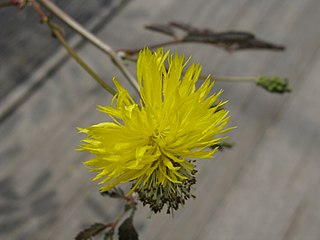 W
WNeptunia oleracea, commonly known in English as water mimosa or sensitive neptunia, is pantropical nitrogen-fixing perennial legume. Genus and common name come from Neptune, god of the sea, in reference to the aquatic habit of some species in the genus.
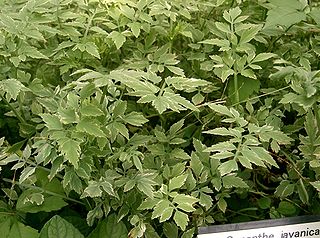 W
WOenanthe javanica, commonly Java waterdropwort, water celery, water dropwort, Chinese celery, and Japanese parsley, is a plant of the genus Oenanthe originating from East Asia. It has a widespread native distribution in temperate Asia and tropical Asia, and is also native to Queensland, Australia.
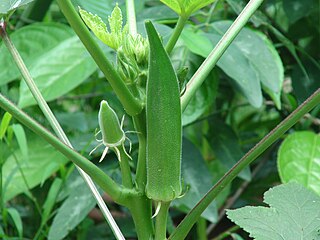 W
WOkra or Okro, Abelmoschus esculentus, known in many English-speaking countries as ladies' fingers or ochro, is a flowering plant in the mallow family. It is valued for its edible green seed pods. It is a good source of minerals, vitamins, antioxidants, and fiber. The geographical origin of okra is disputed, with supporters of West African, Ethiopian, and South Asian origins. The plant is cultivated in tropical, subtropical and warm temperate regions around the world and is a notable part of the cuisine of the Southern United States and India.
 W
WParkia speciosa is a plant of the genus Parkia in the family Fabaceae. It bears long, flat edible beans with bright green seeds the size and shape of plump almonds which have a rather peculiar smell, similar to, but stronger than that of the shiitake mushroom, due to sulfur-containing compounds also found in shiitake, truffles and cabbage.
 W
WPiper sarmentosum is a plant in the family Piperaceae used in many Southeast Asian cuisines. The leaves are often confused with betel, but they lack the intense taste of the betel leaves and are significantly smaller.
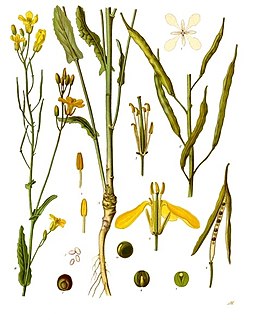 W
WRapeseed, also known as rape, or oilseed rape, is a bright-yellow flowering member of the family Brassicaceae, cultivated mainly for its oil-rich seed, which naturally contains appreciable amounts of erucic acid. Canola are a group of rapeseed cultivars which were bred to have very low levels of erucic acid and are especially prized for use for human and animal food. Rapeseed is the third-largest source of vegetable oil and the second-largest source of protein meal in the world.
 W
WScallions are vegetables derived from various species in the genus Allium. Scallions have a milder taste than most onions. Their close relatives include garlic, shallot, leek, chive, and Chinese onions.
 W
WSenna siamea, also known as Siamese cassia, kassod tree, cassod tree and cassia tree, is a legume in the subfamily Caesalpinioideae. It is native to South and Southeast Asia, although its exact origin is unknown.
 W
WThe shallot is a botanical variety of the onion. Until 2010, the shallot was classified as a separate species, Allium ascalonicum, a name that is a synonym of Allium cepa, the species name of the onion. A. cepa is the correct name for the shallot species.
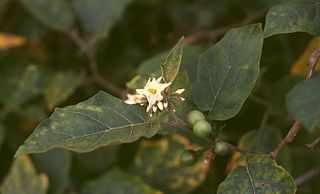 W
WSolanum torvum, the turkey berry, devil's fig, pea eggplant, platebrush or susumber, is a bushy, erect and spiny perennial plant used horticulturally as a rootstock for eggplant. Grafted plants are very vigorous and tolerate diseases affecting the root system, thus allowing the crop to continue for a second year.
 W
WSprouting is the natural process by which seeds or spores germinate and put out shoots, and already established plants produce new leaves or buds or other newly developing parts experience further growth.
 W
WThai eggplant is the name for several varieties of eggplant used in Southeast Asian cuisines, most often of the eggplant species Solanum melongena. They are also cultivated in India and Sri Lanka and feature in Sri Lankan cuisine. These golf ball sized eggplants are commonly used in Thai cuisine, Indonesian cuisine, and in Cambodian Cuisine. Some of the cultivars in Thailand are Thai Purple, Thai Green, Thai Yellow, and Thai White.
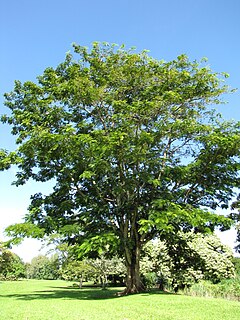 W
WParkia timoriana is a species of flowering plant in the legume family. English common names include tree bean. It is native to Thailand, Malaysia, Myanmar, Indonesia, and Assam and Manipur in India. It is widely cultivated for food and wood, and as an ornamental.
 W
WIpomoea aquatica is a semi-aquatic, tropical plant grown as a vegetable for its tender shoots. This plant is known in English as water spinach, river spinach, water morning glory, water convolvulus, or by the more ambiguous names Chinese spinach, Chinese watercress, Chinese convolvulus or swamp cabbage, or kangkong in Southeast Asia and ong choy in Cantonese. Its place of origin is not known.
 W
WWatercress or yellowcress is a species of aquatic flowering plant in the cabbage family Brassicaceae. Its botanical name is Nasturtium officinale.